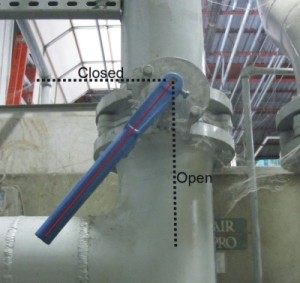
Stop it. You are making my job too easy. I have to go into your facilities for audits, retro-commissioning, and commissioning projects, and in at least 80% of them I find a pump with a substantially throttled (closed) discharge valve. And I don’t mean 20-30% closed. I’m talking 50-95%. Who the heck sizes these things? What happened?! Did you have an extra 60 horsepower pump lying around and figure that’s a bit cheaper than a new 15 horsepower version that would have done the job? Wait. Nevermind. Sometimes it’s just better not to ask.
But I digress. Where was I? Oh yeah, I was giving away my trick to finding one of the fastest payback measures that I get to take “credit” for ALL THE TIME. And if you know what a pump looks like, you can do it too. The first thing you need to do is figure out which direction water is flowing out of your pump and then look for one of two things right after the pump outlet: there’s usually either a manual hand valve, or a triple duty valve that can slow down flow. On the manual hand valve, normally the valve handle will line up with the pipe when it is open, and go perpendicular with it when it is closed (although there is a wide range of valves out there). A triple duty valves should have a little protruding measurement device that tells you how far the valve is open (0% is closed). Now, if you’ve found either one that’s more than 40% closed, go ahead and do your happy dance, because you just found a little pot of gold.
Fixing this problem is usually a 3 year payback (or less) these days because the pump is burning next to its full amount of energy every second it’s on. If the pump is significantly oversized it is wasting plenty of energy. The payback gets faster the more hours the pump runs every year. Do you have any that operate continuously? No brainers.
The easiest method for correcting this problem is by adding a variable frequency drive (VFD) to the unit and turning down the flow by reducing the speed, and thus power to the pump. Note that a pump at full speed with throttled/restricted flow uses less power at than one with no throttling at full speed. So changing pump speed is a must. This is a very non-invasive method, although you do have to a pump motor that is “inverter duty” rated so the VFD doesn’t pit your motor bearings. Other methods for getting your energy savings include installing a properly sized pump and motor (DUH), or trimming the current pump impeller. These are a bit more invasive but can cost less and be just as effective.
With that, stop what you’re doing and go look at your pumps. Seriously. Stop reading. Right now. I told you to stop reading and go look at your pumps! Ugh, alright, I’ll do it myself, but I’m starting to feel bad about it. It feels like taking candy from a baby.




